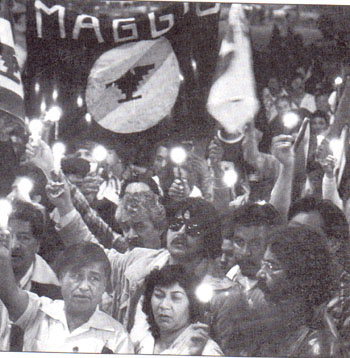History of the UFW

Throughout the course of United States
history, there had been many reasons for unsuccessful organization of
farmworkers. The National Farm Labor Union, which was led by Ernesto
Galarza, in the 1940's and 1950's, enjoyed moderate success but many
obstacles were presented to the organization through the growers'
manipulation of the bracero program. One individual,
César Chávez, with the help
of many important people overcame this obstacle, and led the first
successful organization of farmworkers in U.S. History.
The story begins with one of the many problems
that destroyed the organizing efforts. Through an informal
arrangement known as the Bracero program, which was an agreement
between the United States and Mexico, which recruited temporary
workers helped depress wages in the sector of agricultural labor.
This program became Public Law in 1951. It began during World War II,
when growers were facing a severe shortage of workers, however this
system continued well after the war had concluded.
One of the important contingents in Public Law 78
stated that no bracero could replace a domestic worker. This
provision was rarely enforced and the main reason the growers lobbied
for the program was to in fact replace the domestic worker. These
bracero workers made it difficult to strike because often time they
could be used as scabs, or strikebreakers. In addition, these bracero
workers could be paid less, which helped depress wages of the farm
workers. In 1964, Chávez was able to band together with other
unions, churches, and community groups that were sensitive to the
civil rights movement to help put pressure on the politicians to end
the bracero program.
The conditions the farmworkers faced were
deplorable. Often times they had no electricity, running water, or
bathrooms. Their homes consisted of tents, or some even lived out of
their cars and trucks. Some had to pay two or more dollars per day
for unheated metal shacks, that were usually infested with
mosquitoes. These shacks did not contain indoor plumbing, or cooking
facilities. These housing arrangements were usually segregated by
race. Working conditions were very similar. None of the ranches
contained portable toilets. Some of the growers made the workers
drink from the same cup, and others were charged up to twenty-five
cents for a cup of water. Child labor was prevalent, whole families
usually worked in the fields. Although there were some laws
preventing the mistreatment of workers, the law was often ignored by
the growers.
There were many attempts to form an organization
to represent farm workers. In 1959, the AWOC, Agricultural Workers
Organizing Committee was formed. It was a branch of the AFL-CIO,
American Federation of Labor-Congress of Industrial Organization. The
predecessor of the AWOC was the AWA, Agricultural Workers
Association, which was founded by Dolores Huerta. The AWOC was
composed of Black, Chicano, Filipino, and Anglo workers. Two of the
early leaders, Dolores Huerta
and Larry Itliong, a Filipino, had
helped the Filipino workers in particular gain experience in
organizing unions and strikes in the fields.
In 1962, a young Chicano named César
Chávez formed the NFWA, National Farmworkers Movement.
Chávez had been the national director of the CSO, Community
Service Organization, but had left when the CSO refused to
concentrate its efforts on organizing farm workers. This organization
worked with communities to solve their problems through organizing
and direct action. He based his new organization that eventually
became the UFW, United Farmworkers Movement in Delano. He traveled
from town to town, trying to convince groups of farm workers to
organize because he hoped one day they would band together and form
an effective union.
For more information on the first strike, click here:
Delano
El Aguila Negra
La Causa
Marcha Modesto
Home
Jaime's Home
Bibliography

